SKODA OCTAVIA 2009 2.G / (1Z) Owner's Manual
Manufacturer: SKODA, Model Year: 2009, Model line: OCTAVIA, Model: SKODA OCTAVIA 2009 2.G / (1Z)Pages: 304, PDF Size: 19.56 MB
Page 221 of 304
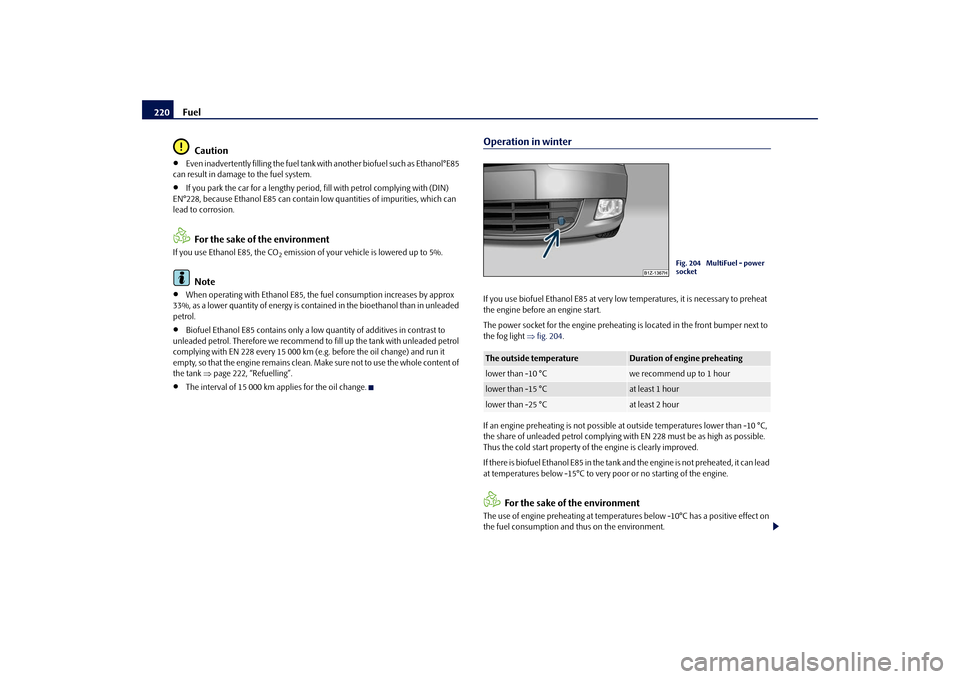
Fuel
220
Caution
•
Even inadvertently filling the fuel tank
with another biofuel such as Ethanol°E85
can result in damage to the fuel system.•
If you park the car for a lengthy period,
fill with petrol complying with (DIN)
EN°228, because Ethanol E85 can contain lo
w quantities of impurities, which can
lead to corrosion.
For the sake of the environment
If you use Ethanol E85, the CO
2 emission of your vehicl
e is lowered up to 5%.
Note
•
When operating with Ethanol E85, the
fuel consumption increases by approx
33%, as a lower quantity of energy is contained in the bioethanol than in unleaded petrol.•
Biofuel Ethanol E85 contains only a low
quantity of additives in contrast to
unleaded petrol. Therefore we recommend to
fill up the tank with unleaded petrol
complying with EN 228 every 15 000 km (e.g. before the oil change) and run it empty, so that the engine remains clean. Make sure not to use the whole content of the tank
⇒page 222, “Refuelling”.
•
The interval of 15 000 km applies for the oil change.
Operation in winterIf you use biofuel Ethanol E85 at very low
temperatures, it is necessary to preheat
the engine before an engine start. The power socket for the engine preheating
is located in the front bumper next to
the fog light
⇒fig. 204
.
If an engine preheating is
not possible at outside temperatures lower than -10 °C,
the share of unleaded petrol complying with
EN 228 must be as high as possible.
Thus the cold start property of the engine is clearly improved. If there is biofuel Ethanol E
85 in the tank and the engine is not preheated, it can lead
at temperatures below -15°C to very poor or no starting of the engine.
For the sake of the environment
The use of engine preheating at temperatures below -10°C has a positive effect on the fuel consumption and thus on the environment.The outside temperature
Duration of engine preheating
lower than -10 °C
we recommend up to 1 hour
lower than -15 °C
at least 1 hour
lower than -25 °C
at least 2 hour
Fig. 204 MultiFuel - power socket
se0.1.book Page 220 Frida
y, April 10, 2009 3:19 PM
Page 222 of 304
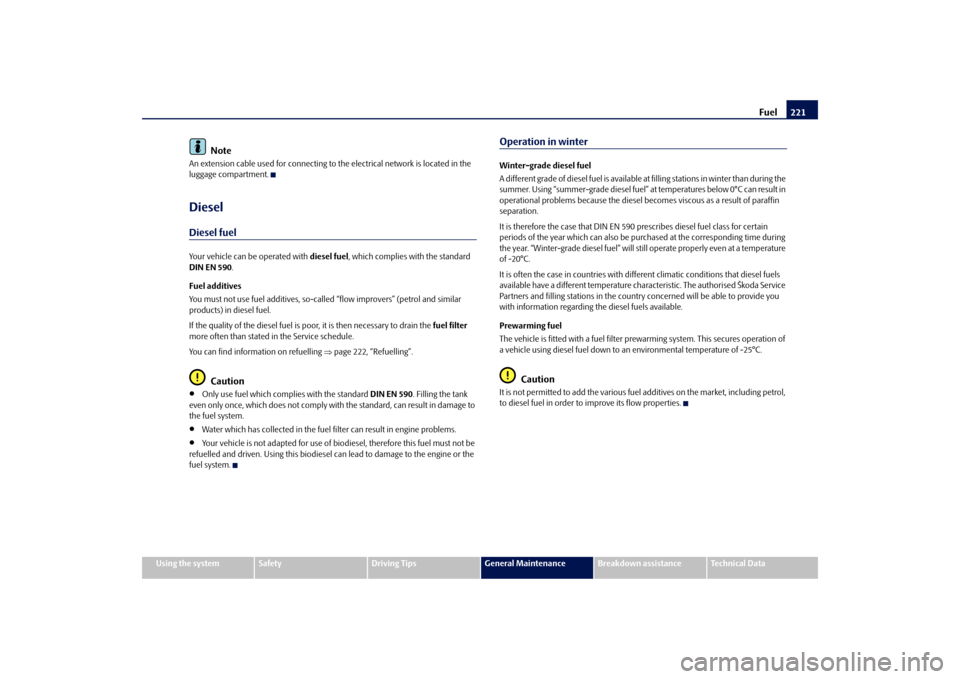
Fuel
221
Using the system
Safety
Driving Tips
General Maintenance
Breakdown assistance
Technical Data
Note
An extension cable used for
connecting to the electrical
network is located in the
luggage compartment.DieselDiesel fuelYour vehicle can be operated with
diesel fuel
, which complies with the standard
DIN EN 590
.
Fuel additives You must not use fuel additives, so-called “flow improvers” (petrol and similar products) in diesel fuel. If the quality of the diesel fuel is p
oor, it is then necessary to drain the
fuel filter
more often than stated in the Service schedule. You can find information on refuelling
⇒page 222, “Refuelling”.
Caution
•
Only use fuel which complies with the standard
DINEN590
. Filling the tank
even only once, which does not comply with
the standard, can result in damage to
the fuel system.•
Water which has collected in the fuel fi
lter can result in engine problems.
•
Your vehicle is not adapted for use of biodiesel, therefore this fuel must not be
refuelled and driven. Using this biodiesel ca
n lead to damage to the engine or the
fuel system.
Operation in winterWinter-grade diesel fuel A different grade of diesel fuel is available at filling stations in winter than during the summer. Using “summer-grade diesel fuel” at temperatures below 0°C can result in operational problems because the diesel be
comes viscous as a result of paraffin
separation. It is therefore the case that DIN EN 590
prescribes diesel fuel class for certain
periods of the year which can also be pu
rchased at the corres
ponding time during
the year. “Winter-grade diesel fuel” will still operate properly even at a temperature of -20°C. It is often the case in countries with different climatic conditions that diesel fuels available have a different temperature characteristic. The authorised Škoda Service Partners and filling stations in the country concerned will be able to provide you with information regarding the diesel fuels available. Prewarming fuel The vehicle is fitted with a fuel filter prewarming system. This secures operation of a vehicle using diesel fuel down to an environmental temperature of -25°C.
Caution
It is not permitted to add the various fuel
additives on the market, including petrol,
to diesel fuel in order to
improve its flow properties.
se0.1.book Page 221 Frida
y, April 10, 2009 3:19 PM
Page 223 of 304
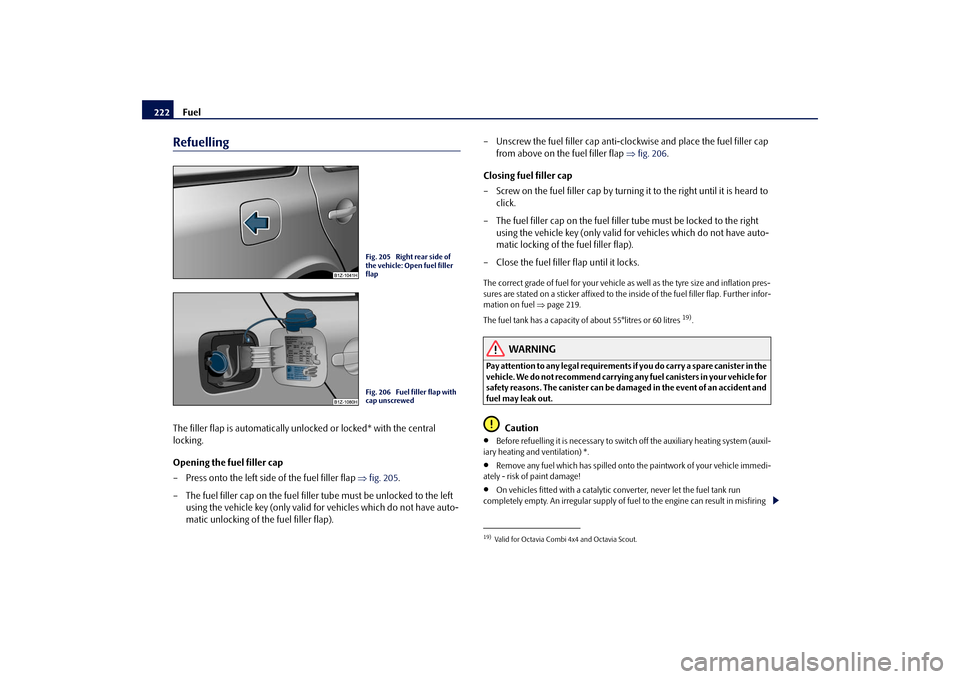
Fuel
222
RefuellingThe filler flap is automatically unlocked or locked* with the central locking. Opening the fuel filler cap – Press onto the left side of the fuel filler flap
⇒
fig. 205
.
– The fuel filler cap on the fuel fille
r tube must be unlocked to the left
using the vehicle key (only valid for
vehicles which do not have auto-
matic unlocking of the fuel filler flap).
– Unscrew the fuel filler cap anti-clo
ckwise and place the fuel filler cap
from above on the fuel filler flap
⇒
fig. 206
.
Closing fuel filler cap – Screw on the fuel filler cap by turning it to the right until it is heard to
click.
– The fuel filler cap on the fuel filler tube must be locked to the right
using the vehicle key (only valid for
vehicles which do not have auto-
matic locking of the fuel filler flap).
– Close the fuel filler flap until it locks.The correct grade of fuel for your vehicle as
well as the tyre size and inflation pres-
sures are stated on a sticker affixed to the inside of the fuel filler flap. Further infor- mation on fuel
⇒page 219.
The fuel tank has a capacity of
about 55°litres or 60 litres
19).
WARNING
Pay attention to any legal requirements if
you do carry a spare canister in the
vehicle. We do not recommend carrying any fuel canisters in your vehicle for safety reasons. The canister can be da
maged in the event of an accident and
fuel may leak out.
Caution
•
Before refuelling it is necessary to switch off the auxiliary heating system (auxil-
iary heating and ventilation) *.•
Remove any fuel which has spilled onto
the paintwork of your vehicle immedi-
ately - risk of paint damage!•
On vehicles fitted with
a catalytic converter, never let the fuel tank run
completely empty. An irregular supply of fu
el to the engine can result in misfiring
Fig. 205 Right rear side of the vehicle: Open fuel filler flapFig. 206 Fuel filler flap with cap unscrewed
19)Valid for Octavia Combi 4x4 and Octavia Scout.
se0.1.book Page 222 Frida
y, April 10, 2009 3:19 PM
Page 224 of 304
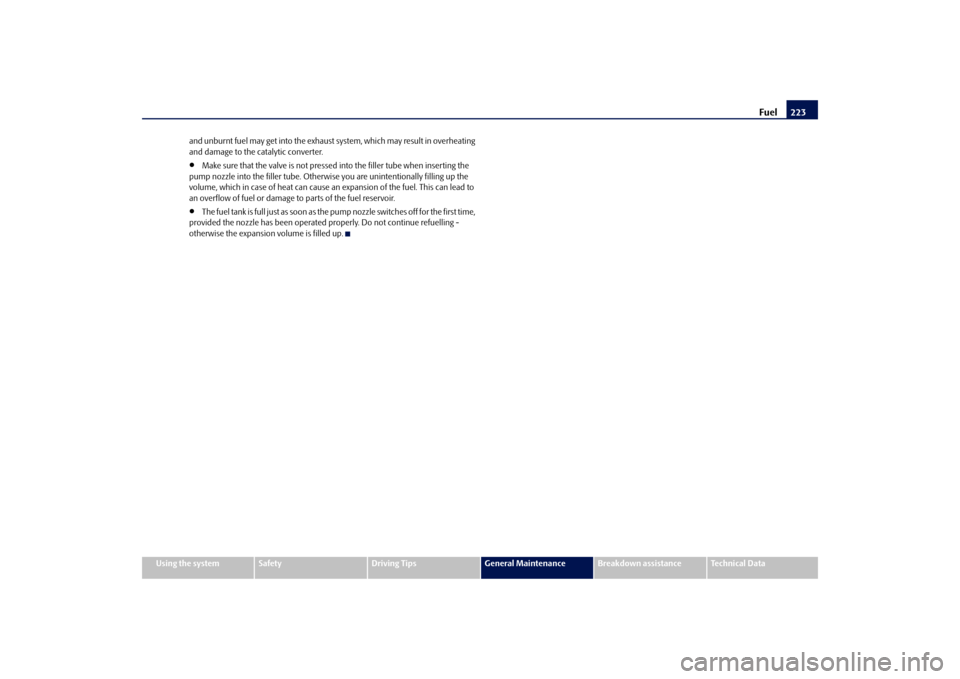
Fuel
223
Using the system
Safety
Driving Tips
General Maintenance
Breakdown assistance
Technical Data
and unburnt fuel may get into
the exhaust system, which may result in overheating
and damage to the
catalytic converter.
•
Make sure that the valve is not pressed into the filler tube when inserting the
pump nozzle into the filler tube. Otherwis
e you are unintentionally filling up the
volume, which in case of heat can cause an
expansion of the fuel. This can lead to
an overflow of fuel or damage
to parts of the fuel reservoir.
•
T h e f u e l t a n k i s f u l l j u s t a s s o o n a s t h
e pump nozzle switches off for the first time,
provided the nozzle has been operated properly. Do not continue refuelling - otherwise the expansion volume is filled up.
se0.1.book Page 223 Frida
y, April 10, 2009 3:19 PM
Page 225 of 304
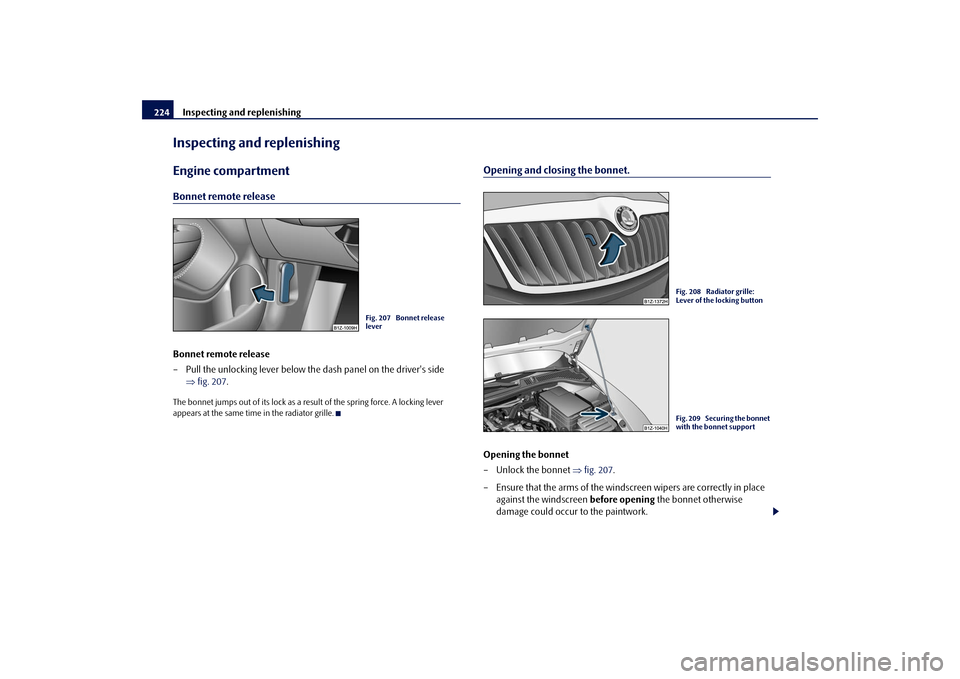
Inspecting and replenishing
224
Inspecting and replenishingEngine compartmentBonnet remote releaseBonnet remote release – Pull the unlocking lever below the
dash panel on the driver's side
⇒
fig. 207
.
The bonnet jumps out of its lock as a result of the spring force. A locking lever appears at the same time in the radiator grille.
Opening and closing the bonnet.Opening the bonnet – Unlock the bonnet
⇒
fig. 207
.
– Ensure that the arms of the windsc
reen wipers are correctly in place
against the windscreen
before opening
the bonnet otherwise
damage could occur to the paintwork.
Fig. 207 Bonnet release lever
Fig. 208 Radiator grille: Lever of the locking buttonFig. 209 Securing the bonnet with the bonnet support
se0.1.book Page 224 Frida
y, April 10, 2009 3:19 PM
Page 226 of 304

Inspecting and replenishing
225
Using the system
Safety
Driving Tips
General Maintenance
Breakdown assistance
Technical Data
– Pulling on the locking lever
⇒
page 224, fig. 208
will unlock the
bonnet fully.
– Grip with the hand under
the radiator grille and lift up the bonnet.
– Take the bonnet support out of its holder and set it in the opening
designed for it
⇒
page 224, fig. 209
.
Closing the bonnet – Lift the bonnet slightly and unhook the bonnet support. Press the
bonnet support into the hold
er designed to hold it.
– Allow the bonnet to drop from a height of about 20 cm into the lock -
bonnet
do not press down on it
!
WARNING
•
Never open the bonnet if you see that steam or coolant is flowing out of
the engine compartment - risk of scaldi
ng! Wait long enough until the steam
or coolant has stopped escaping.•
For safety reasons, the bonnet must always be properly closed when
driving. One should therefore check that
the lock has in fact engaged prop-
erly after closing the bonnet.•
Stop your vehicle immediately while driv
ing if you notice that the lock is
not properly engaged and close the bonne
t properly - risk of an accident!
Caution
Never open the bonnet using the locking lever - danger of causing damage.Working in the engine compartment Particular care is required when carrying out any work in the engine compartment!There is a risk of injuries, scalding,
accidents and fire when working in the
engine compartment, e.g. inspecting and replenishing oil and other fluids. For
this reason, it is essential to comply with the warning instructions stated below and with the general applicable
rules of safety. The engine compart-
ment of your car is a hazardous area
⇒
.
WARNING
•
Never open the bonnet if you see that steam or coolant is flowing out of
the engine compartment - risk of scaldi
ng! Wait long enough until the steam
or coolant has stopped escaping.•
Switch off the engine and pull out the ignition key.
•
Apply the handbrake firmly.
•
If your vehicle is fitted with a ma
nual gearbox, move the gearshift lever
into Neutral, or if it is fitted with
automatic gearbox, move the selector lever
into position P.•
Allow the engine to cool down.
•
Keep children clear of the engine compartment.
•
Never spill oil and other fluids over the hot engine. Such fluids (e.g. the
antifreeze contained in the coolant) may ignite!•
Avoid short circuits in the electrical system - particularly on the battery.
•
Never place your hand into the radiator fan as long as the engine is still
warm. The fan might suddenly start running!•
Never open the cap of the coolant expa
nsion bottle as long
as the engine
is still warm. The cooling system is pressurized!•
Cover over the cap of the coolant expansion reservoir with a large cloth
when opening it as protection for your
face, hands and arms from hot steam
or hot coolant.•
Do not let objects, such as e.g cleani
ng cloth or tools lie in the engine
compartment.•
If you wish to work under the vehicle, you must secure the vehicle from
rolling away and support it with suitab
le supporting blocks
; the lifting jack*
is not sufficient for this - risk of injury!•
In cases where it be necessary to carry out inspection work when the
engine is running there is an additional risk from rotating parts (e.g. the V-
se0.1.book Page 225 Frida
y, April 10, 2009 3:19 PM
Page 227 of 304
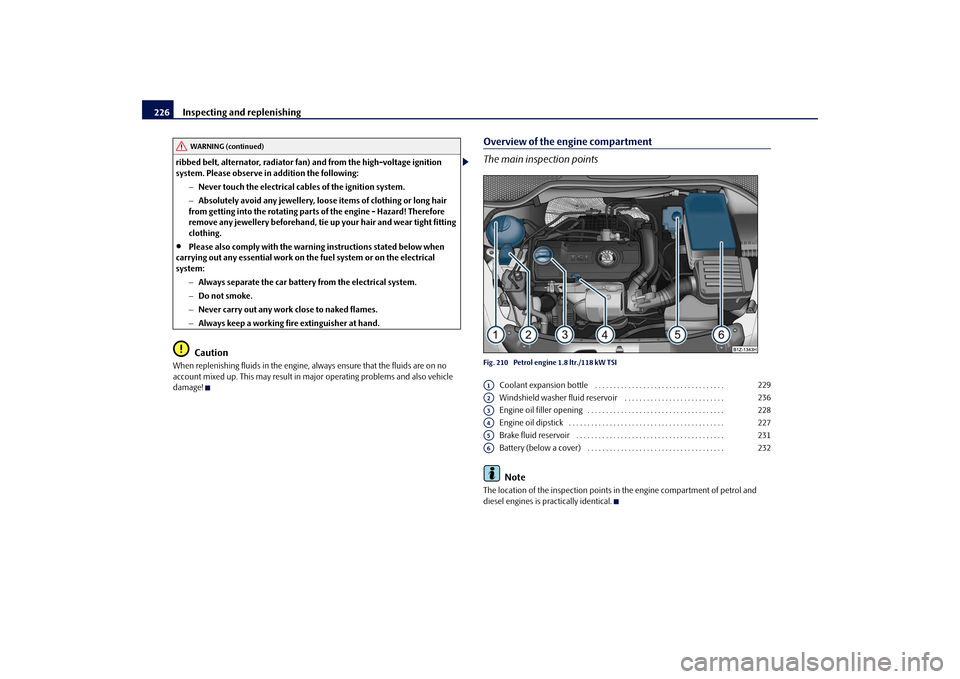
Inspecting and replenishing
226
ribbed belt, alternator, radiator fan) and from the high-voltage ignition system. Please observe in addition the following:
− Never touch the electrical cabl
es of the ignition system.
− Absolutely avoid any jewellery, loose items of clothing or long hair from getting into the rotating parts of the engine - Hazard! Therefore remove any jewellery beforehand, tie up your hair and wear tight fitting clothing.
•
Please also comply with the warnin
g instructions st
ated below when
carrying out any essential work on the fuel system or on the electrical system:
− Always separate the car batter
y from the electrical system.
− Do not smoke. − Never carry out any work close to naked flames. − Always keep a working fire
extinguisher at hand.
Caution
When replenishing fluids in the engine, always ensure that the fluids are on no account mixed up. This may result in ma
jor operating problems and also vehicle
damage!
Overview of the engine compartment The main inspection pointsFig. 210 Petrol engine 1.8 ltr./118 kW TSI
Coolant expansion bottle . . . . . . . . . . . . . . . . . . . . . . . . . . . . . . . . . . . Windshield washer fluid reservoir . . . . . . . . . . . . . . . . . . . . . . . . . . . Engine oil filler opening . . . . . . . . . . . . . . . . . . . . . . . . . . . . . . . . . . . . . Engine oil dipstick . . . . . . . . . . . . . . . . . . . . . . . . . . . . . . . . . . . . . . . . . . Brake fluid reservoir . . . . . . . . . . . . . . . . . . . . . . . . . . . . . . . . . . . . . . . . Battery (below a cover) . . . . . . . . . . . . . . . . . . . . . . . . . . . . . . . . . . . . . Note
The location of the inspection points in
the engine compartment of petrol and
diesel engines is practically identical.
WARNING (continued)
A1
229
A2
236
A3
228
A4
227
A5
231
A6
232
se0.1.book Page 226 Frida
y, April 10, 2009 3:19 PM
Page 228 of 304

Inspecting and replenishing
227
Using the system
Safety
Driving Tips
General Maintenance
Breakdown assistance
Technical Data
Engine oilCheck engine oil level The dipstick indicates the level of oil in the engine.Checking the oil level – Ensure that the vehicle is positioned on a level surface. – Switch the engine off. – Open the bonnet
⇒
in “Working in the engine compartment” on
page 225.
– Wait a few minutes and pull out the oil dipstick.– Wipe off the dipstick with a clea
n cloth and insert it again fully.
– Then withdraw the dipstick ag
ain and read off the oil level.
Oil level within range – You must
not
top up the oil.
Oil level within range –You
may
top up the oil. It is possible that the oil level may then be
within range after doing this.
Oil level within range –You
must
top up the oil
⇒
page 228. It is sufficient, once this is done,
to keep the oil level within range .
It is normal for the engine to consume oi
l. The oil consumption may be as much as
0.5 l/1 000 km depending on your style of driving and the conditions under which you operate your vehicle. The oil consumpt
ion may be slightly higher than this
during the first 5 000 kilometres. One should therefore check the oil level at regular intervals, preferably every time after the fuel tank is filled or after driving for long stretches. We recommend maintaining the oil level within the range -
but not above this
,
if the engine has been operating at hi
gh loads, for example during a lengthy
motorway trip during the summer months,
towing a trailer or negotiating a high
mountain pass. The warning light in the instrument cluster* will indicate
⇒page 35, “Engine oil
pressure
” whether the oil level is too low. In this case, check the oil level as soon
as possible. Top up with an appropriate quantity of oil.
Caution
•
The oil level must on no account ex
tend beyond the range . Danger of
damaging the cata
lytic converter.
•
Do not continue your journey
if for some reason it is not possible under the
conditions prev
ailing to top up with oil.
Switch of the engine and contact
and
obtain professional assistance from a specialist garage.
Note
Engine oil specifications
⇒page 271, “Technical Data”.
Fig. 211 Dipstick
AA
AB
AA
AC
AB
AA
AA
se0.1.book Page 227 Frida
y, April 10, 2009 3:19 PM
Page 229 of 304
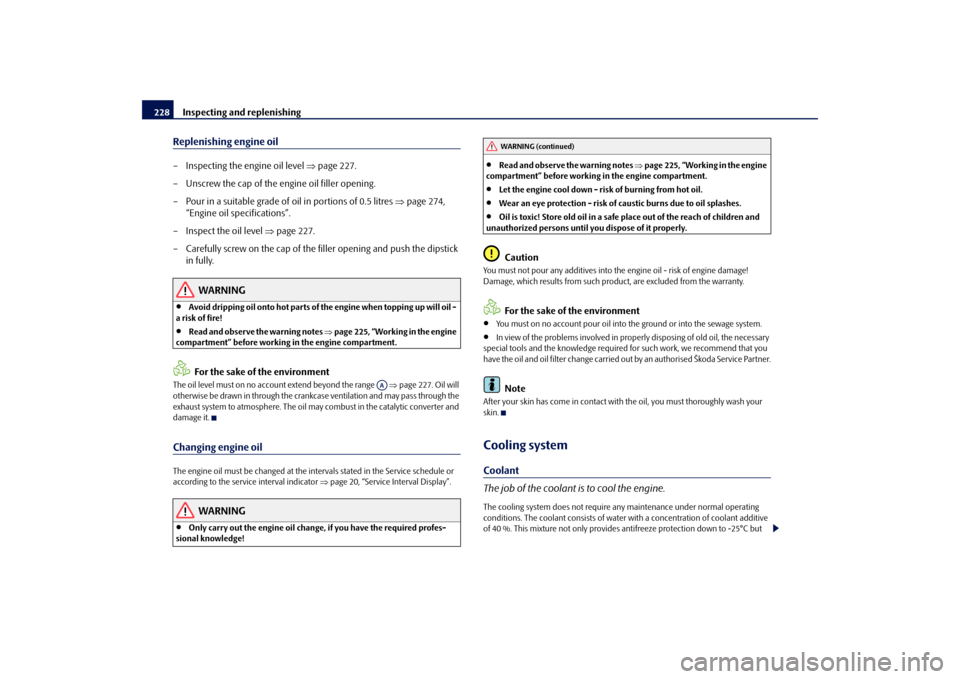
Inspecting and replenishing
228
Replenishing engine oil– Inspecting the engine oil level
⇒
page 227.
– Unscrew the cap of the engine oil filler opening. – Pour in a suitable grade of oil in portions of 0.5 litres
⇒
page 274,
“Engine oil specifications”.
– Inspect the oil level
⇒
page 227.
– Carefully screw on the cap of the
filler opening and push the dipstick
in fully.
WARNING
•
Avoid dripping oil onto hot parts of the engine when topping up will oil -
a risk of fire!•
Read and observe the warning notes
⇒page 225, “Working in the engine
compartment” before working in the engine compartment.
For the sake of the environment
The oil level must on no account extend beyond the range
⇒page 227. Oil will
otherwise be drawn in through the crankc
ase ventilation and may pass through the
exhaust system to atmosphere. The oil ma
y combust in the cata
lytic converter and
damage it.Changing engine oilThe engine oil must be changed at the intervals stated in the Service schedule or according to the service interval indicator
⇒page 20, “Service Interval Display”.
WARNING
•
Only carry out the engine oil change, if you have the required profes-
sional knowledge!
•
Read and observe the warning notes
⇒page 225, “Working in the engine
compartment” before working in the engine compartment.•
Let the engine cool down - risk of burning from hot oil.
•
Wear an eye protection - risk of caustic burns due to oil splashes.
•
Oil is toxic! Store old oil in a safe place out of the reach of children and
unauthorized persons until you dispose of it properly.
Caution
You must not pour any additives into th
e engine oil - risk of engine damage!
Damage, which results from such produc
t, are excluded from the warranty.
For the sake of the environment
•
You must on no account pour oil into
the ground or into the sewage system.
•
In view of the problems involved in prop
erly disposing of old oil, the necessary
special tools and the knowledge required for such work, we recommend that you have the oil and oil filter change carried out by an authorised Škoda Service Partner.
Note
After your skin has come in contact with the oil, you must thoroughly wash your skin.Cooling systemCoolant The job of the coolant is to cool the engine.The cooling system does not require an
y maintenance under normal operating
conditions. The coolant consis
ts of water with a concentration of coolant additive
of 40 %. This mixture not only provides
antifreeze protection down to -25°C but
AA
WARNING (continued)
se0.1.book Page 228 Frida
y, April 10, 2009 3:19 PM
Page 230 of 304
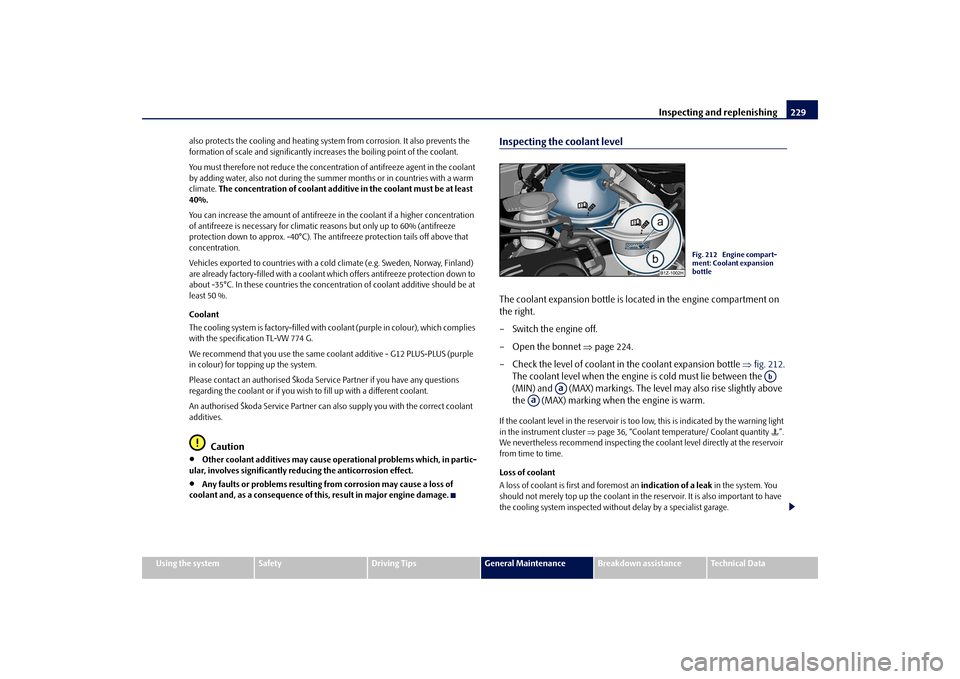
Inspecting and replenishing
229
Using the system
Safety
Driving Tips
General Maintenance
Breakdown assistance
Technical Data
also protects the cooling and heating system from corrosion. It also prevents the formation of scale and significantly increases the boiling point of the coolant. You must therefore not reduce the concentr
ation of antifreeze agent in the coolant
by adding water, also not during the summ
er months or in countries with a warm
climate.
The concentration of coolant additive in the coolant must be at least
40%. You can increase the amount of antifreeze
in the coolant if a higher concentration
of antifreeze is necessary for climatic
reasons but only up to 60% (antifreeze
protection down to approx. -40°C). The an
tifreeze protection tails off above that
concentration. Vehicles exported to countries with a co
ld climate (e.g. Sweden, Norway, Finland)
are already factory-filled with a coolant wh
ich offers antifreeze protection down to
about -35°C. In these countries the concentr
ation of coolant additive should be at
least 50 %. Coolant The cooling system is factory-filled with co
olant (purple in colour), which complies
with the specification TL-VW 774 G. We recommend that you use the same c
oolant additive - G12 PLUS-PLUS (purple
in colour) for toppi
ng up the system.
Please contact an authorised Škoda Service Partner if you have any questions regarding the coolant or if you wish to fill up with a different coolant. An authorised Škoda Service Partner can al
so supply you with the correct coolant
additives.
Caution
•
Other coolant additives may cause operational problems which, in partic-
ular, involves significantly redu
cing the anticorrosion effect.
•
Any faults or problems resulting from corrosion may cause a loss of
coolant and, as a consequence of th
is, result in major engine damage.
Inspecting the coolant levelThe coolant expansion bottle is loca
ted in the engine compartment on
the right. – Switch the engine off. – Open the bonnet
⇒
page 224.
– Check the level of coolant in the coolant expansion bottle
⇒
fig. 212
.
The coolant level when the engine is cold must lie between the (MIN) and (MAX) markings. The level may also rise slightly above the (MAX) marking when the engine is warm.
If the coolant level in the reservoir is too low, this is indicated by the warning light in the instrument cluster
⇒page 36, “Coolant temperat
ure/ Coolant quantity
”.
We nevertheless recommend in
specting the coolant level directly at the reservoir
from time to time. Loss of coolant A loss of coolant is first and foremost an
indication of a leak
in the system. You
should not merely top up the coolant in the
reservoir. It is also important to have
the cooling system inspected without delay by a specialist garage.
Fig. 212 Engine compart- ment: Coolant expansion bottle
Ab
Aa
Aa
se0.1.book Page 229 Frida
y, April 10, 2009 3:19 PM